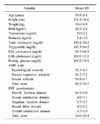Abstract
Purpose
The aim of this study is to analyze the correlation between the Androgen Deficiency in Aging Males (ADAM) questionnaire and the Aging Males' Symptoms (AMS) scale and to determine their relationship with the serum testosterone level.
Materials and Methods
We retrospectively reviewed the medical records of the patients who took the self-administered ADAM questionnaire, the AMS scale and the International Index of Erectile Function (IIEF) questionnaire. We enrolled a total of 265 patients older than 40 years who presented a positive result for the ADAM questionnaire (defined as a 'yes' answer to question 1 or 7, or a 'yes' answer to at least three of the other questions). Blood tests were performed, including the total testosterone, prolactin, the lipid profiles and the fasting glucose level.
Results
The psychological subscale of the AMS scale was correlated with ADAM questions 2, 3, 5, 7, 8 and 10 (p<0.005) and the somato-vegetative subscale was correlated with questions 2, 3, 5, 6, 8 and 10 (p<0.05). The sexual subscale was correlated with questions 1, 2, 5, 6, 7, 8 and 10 (p<0.05). Statistically significant differences were found for the IIEF questionnaire scores between the patients with 'yes' and 'no' answer to ADAM question 1 and 7 (p<0.05). The IIEF questionnaire scores were significantly lower for the men with a sexual subscale score 11-25 on the AMS scale (p<0.05). The total testosterone was not correlated with the ADAM, AMS and IIEF questionnaire but the total testosterone demonstrated a significantly negative correlation with weight, abdominal circumference, body mass index (BMI) and triglyceride (p<0.05).
Conclusions
This analysis revealed that the ADAM questionnaire and the AMS scale have a significant relationship, and especially the sexual function domain of the two questionnaires showed correlation with the IIEF questionnaire. Serum testosterone was related with weight, abdominal circumference, BMI and triglyceride.
Figures and Tables
References
1. Werner AA. The male climacteric. J Am Med Assoc. 1939. 112:1441–1443.
2. Morley JE, Kaiser F, Raum WJ, Perry HM 3rd, Flood JF, Jensen J, et al. Potentially predictive and manipulable blood serum correlates of aging in the healthy human male: progressive decreases in bioavailable testosterone, dehydroepiandrosterone sulfate, and the ratio of insulin-like growth factor 1 to growth hormone. Proc Natl Acad Sci USA. 1997. 94:7537–7542.
3. Brown-Sequard CE. Effects in man of subcutaneous injections of freshly prepared liquid from guinea pig and dog testes. C R Seances Soc Biol Ser. 1889. 9:415–419.
4. Schiavi RC, White D, Mandeli J, Levine AC. Effect of testosterone administration on sexual behavior and mood in men with erectile dysfunction. Arch Sex Behav. 1997. 26:231–241.
5. Janowsky JS, Oviatt SK, Orwoll ES. Testosterone influences spatial cognition in older men. Behav Neurosci. 1994. 108:325–332.
6. Urban RJ, Bodenburg YH, Gilkison C, Foxworth J, Coggan AR, Wolfe RR, et al. Testosterone administration to elderly men increases skeletal muscle strength and protein synthesis. Am J Physiol. 1995. 269:E820–E826.
7. Sih R, Morley JE, Kaiser FE, Perry HM 3rd, Patrick P, Ross C. Testosterone replacement in older hypogonadal men: a 12-month randomized controlled trial. J Clin Endocrinol Metab. 1997. 82:1661–1667.
8. Hajjar RR, Kaiser FE, Morley JE. Outcomes of long-term testosterone replacement in older hypogonadal males: a retrospective analysis. J Clin Endocrinol Metab. 1997. 82:3793–3796.
9. Martínez-Jabaloyas JM, Queipo-Zaragoza A, Rodríguez-Navarro R, Queipo-Zaragozá JA, Gil-Salom M, Chuan-Nuez P. Relationship between the Saint Louis University ADAM questionnaire and sexual hormonal levels in a male outpatient population over 50 years of age. Eur Urol. 2007. 52:1760–1767.
10. Kelleher S, Conway AJ, Handelsman DJ. Blood testosterone threshold for androgen deficiency symptoms. J Clin Endocrinol Metab. 2004. 89:3813–3817.
11. Morley JE, Charlton E, Patrick P, Kaiser FE, Cadeau P, McCready D, et al. Validation of a screening questionnaire for androgen deficieny in aging males. Metabolism. 2000. 49:1239–1242.
12. Kim SW, Oh SJ, Paick JS, Kim SC. Development of the Korean-translation of Androgen Deficiency in Aging Males (ADAM) Questionnaire. Korean J Urol. 2004. 45:674–679.
13. Heinemann LA, Zimmermann T, Vermeulen A, Thiel C. A new 'Aging Male's Symptoms' (AMS) scale. Aging Male. 1999. 2:105–114.
14. Daig I, Heinemann LA, Kim S, Leungwattanakij S, Badia X, Myon E, et al. The Aging Males' Symptoms (AMS) scale: review of its methodological characteristics. Health Qual Life Outcomes. 2003. 1:77.
15. Smith KW, Feldman HA, Mckinlay JB. Construction and field validation of a self-administered screener for testosterone deficiency (hypogonadism) in ageing men. Clin Endocrinol. 2000. 53:703–711.
16. Gray A, Feldman HA, McKinlay JB, Longcope C. Age, disease, and changing sex hormone levels in middle-aged men: results of the Massachusetts Male Aging Study. J Clin Endocrinol Metab. 1991. 73:1016–1025.
17. Morley JE, Kaiser FE, Perry HM 3rd, Patrick P, Morley PM, Stauber PM, et al. Longitudinal changes in testosterone, luteinizing hormone, and follicle-stimulating hormone in healthy older men. Metabolism. 1997. 46:410–413.
18. Araujo AB, O'Donell AB, Brambilla DJ, Simpson WB, Longcope C, Matsumoto AM, et al. Prevalence and incidence of androgen deficiency in middle-aged and older men: estimates from the Massachusetts Male Aging Study. J Clin Endocrinol Metab. 2004. 89:5920–5926.
19. Tancredi A, Reginster JY, Schleich F, Pire G, Maassen P, Luyckx F, et al. Interest of the Androgen Deficiency in Aging Males (ADAM) questionnaire for the identification of hypogonadism in elderly community-dwelling male volunteers. Eur J Endocrinol. 2004. 151:355–360.
20. Basar MM, Aydin G, Mert HC, Keles I, Caglayan O, Okrun S, et al. Relationship between serum sex steroids and Aging male symptoms score and International Index of Erectile Function. Urology. 2005. 66:597–601.
21. Heinemann LA, Moore C, Dinger JC, Stoehr D. Sensitivity as outcome measure of androgen replacement: the AMS scale. Health Qual Life Outcomes. 2006. 4:23.
22. Morley JE, Perry HM 3rd, Kevorkian RT, Patrick P. Comparison of screeing questionnaires for the diagnosis of hypogonadism. Maturitas. 2006. 53:424–429.
23. Morley JE, Patrick P, Perry HM 3rd. Evaluation of assays available to measure free testosterone. Metabolism. 2002. 51:554–559.




 PDF
PDF ePub
ePub Citation
Citation Print
Print







 XML Download
XML Download